Before Stonewall: 6 Pivotal Events in LGBTQIA+ Modern American History
For folks across the US, this Pride Month has hardly felt like a celebration. In a moment where civil rights for marginalized folks feel threatened, it’s essential to remember that Pride started as a protest — not a party.
In the 1960s, the gay liberation movement as we know it began to take shape, using methods successfully employed by the Civil Rights Movement. At this time, all 50 states criminalized same-sex sexual activity — a position that wouldn’t be unilaterally overturned until 2003, when the US Supreme Court issued a landmark ruling in the case of Lawrence v. Texas.
At this time, people who were suspected of homosexuality were routinely humiliated and brutalized by police officers. A common tactic was the “masquerade” or “three-article law,” in which a person could be arrested if police determined that they were wearing three or more articles of clothing not associated with the gender on their government ID.
Criminalized and excluded by society at large, queer people struggled to find safe spaces to gather, work, and live. Establishments that broke the law to serve gay and trans (at the time referred to as drag queens, although the word has a totally different meaning today) folks were often subjected to police raids. Perhaps the most well-known story of such a raid took place at the Stonewall Inn, a Mafia-run bar in New York. However, police efforts were thwarted when patrons, notably led by trans women of color, fought back.
The story of Stonewall is essential to understanding the complicated history of LGBTQIA+ rights in the US — and there are books, podcasts, and documentaries that share the story with care and nuance.
In the decade before the uprising on Christropher Street, six other events laid the foundation for the movement to take off. This list is not meant to be exhaustive or the comprehensive authority on a complicated collective history. Instead, consider this an intro to the mid-20th century gay rights movement. Because we can’t cover it all, we’ve included additional resources for each event.
Cooper’s Do-nut May 1959
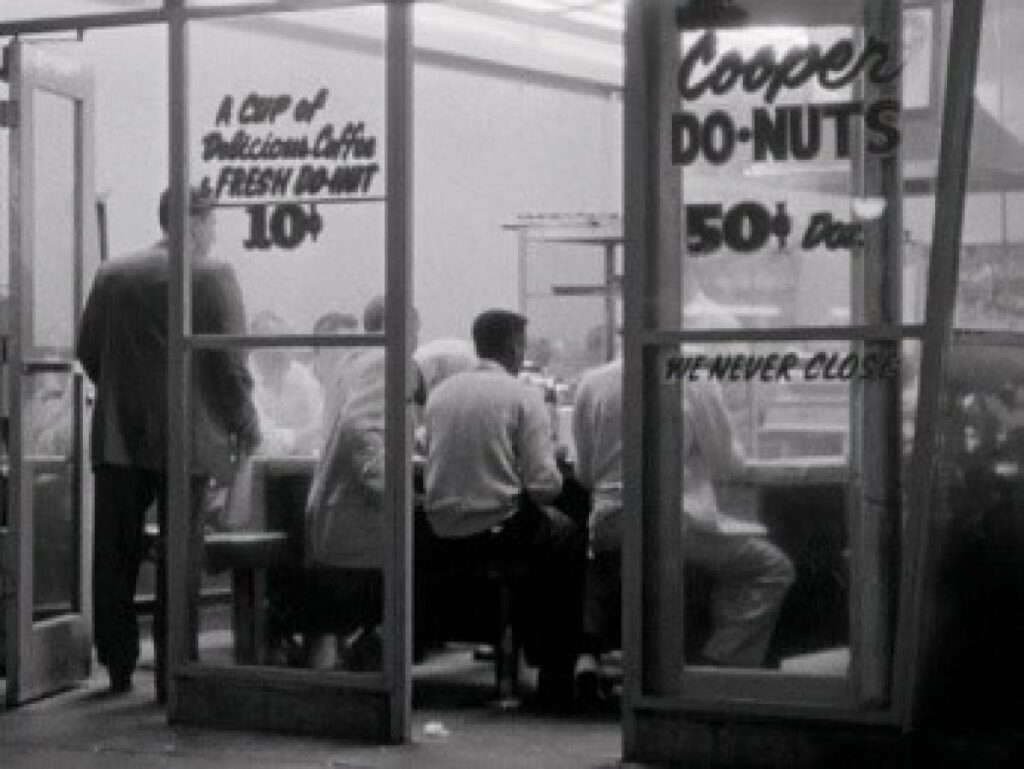 Nestled in between gay and lesbian bars in Los Angeles’ Skid Row neighborhood, Cooper’s Do-Nut had a reputation for welcoming LGBTQIA+ folks and sex workers, in part because it was open 24 hours per day, the Los Angeles Public Library (LAPL) writes. Unfortunately, the patron’s safety fell into jeopardy when William H. Parker became the chief of the LAPD in the 1950s. Under Parker, arrests for homosexuality increased by 85%, according to USC.
Nestled in between gay and lesbian bars in Los Angeles’ Skid Row neighborhood, Cooper’s Do-Nut had a reputation for welcoming LGBTQIA+ folks and sex workers, in part because it was open 24 hours per day, the Los Angeles Public Library (LAPL) writes. Unfortunately, the patron’s safety fell into jeopardy when William H. Parker became the chief of the LAPD in the 1950s. Under Parker, arrests for homosexuality increased by 85%, according to USC.
On a night in May 1959, cops entered Cooper’s and targeted five patrons suspected of “masquerading.” Ultimately, police proceeded to arrest two drag queens, two sex workers, and a gay man, loading them all into one car. When the cops got to the fifth person, they refused to be arrested.
That final patron’s resistance incited a riot, with customers at Cooper’s and nearby bars joining in. A large crowd of LGTBQIA+ folks, drag queens, and sex workers gathered and threw items at the police — including donuts, paper plates, and coffee cups, from Cooper’s.
Amid the chaos, the cops left to find reinforcements. In their absence, the crowd reveled in the complicated emotions of the night. “The street was bustling with disobedience. Gay people danced about the cars,” eyewitness John Rechy wrote in the novel City of Night, which is one of the only known accounts of the evening.
Eventually, the police returned, arresting an undetermined number of people in the crowd. Like Stonewall, little is known about the details of the night. According to the Los Angeles Almanac, Rechy’s is the only written evidence of this event — historians are still seeking out news articles or police reports to confirm his account.
More on Cooper’s Do-Nut:
Novel: “City of Night” by John Rechy
Podcast: Totally Trans Podcast Network: Cooper Do-nuts Riot
Dewey’s Lunch Counter – April 21, 1965
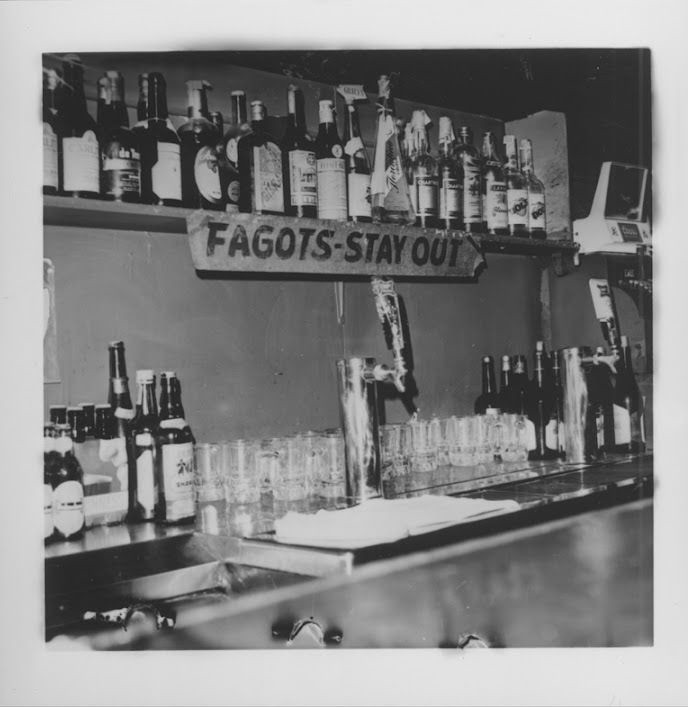
Anti-LGBTQIA+ sign displayed inside of Dewy’s Lunch Counter
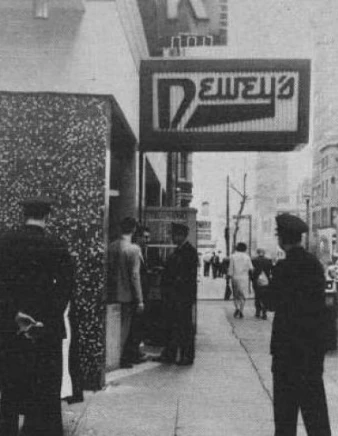
In the 1960s, Dewey’s, a hamburger chain founded in New Jersey, expanded into the Philadelphia area. At its peak, the chain had 15 locations, including two spots in Philly, which were popular among LGTBQIA+ folks — one on Seventeenth Street and another on Thirteenth Street, the Philadelphia Encyclopedia reports.
In the spring of 1965, management prohibited employees from serving LGBTQIA+ folks, as the higher-ups had become apparently bothered by a group of gender-non-conforming teens at the restaurant.
The teens sought the support of the Janus Society, a more radical homophile organization, to organize a sit-in, as the tactic had been effective for leaders of the civil rights movement. On April 25, 1965, 150 LGTBQIA+ folks visited Dewey’s on Seventeenth Street. They were all refused service. Three unidentified teens and Clark Polak, the president of the Janus Society, were arrested on charges of disorderly conduct.
After the April 25, sit-in, the Janus Society protested outside of the burger shop. Over five days, they distributed over 1,5000 leaflets and organized another protest.
On May 2, a smaller group held a sit-in at Dewey’s. While police were present, no one was arrested. In fact, Dewey’s ultimately reversed their prohibition and agreed to let queer folks back to the lunch counter.
This event is widely regarded as an early victory of the movement.
More on Dewey’s:
Podcast: Your Queer Story: An LGBTQ+ Podcast: The Janus Society and Deweys
Book: “City of Sisterly and Brotherly Loves: Lesbian and Gay Philadelphia” by Marc Stein
Reminder Day Picket July 4, 1965-9
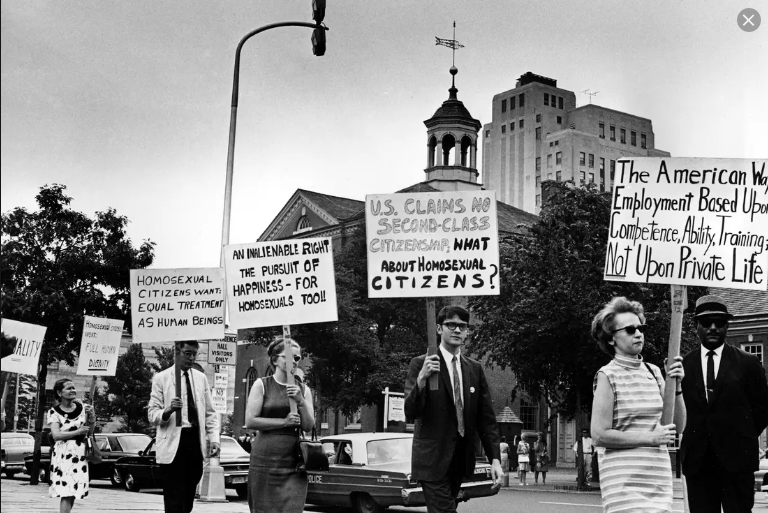
July 4, 1965, first annual Reminder Day protest
One of the earliest actions of queer visibility was the Annual Reminder, which took place in Philadelphia. The event served to be, as the name suggests, an annual picket to remind folks that LGBTQIA+ people were discriminated against.
The Philadelphia event was inspired by a comparable demonstration organized by the Mattachine Society in Washington, DC. It was organized by the East Coast Homophile Organization under the leadership of activist Barbara Gittings and Frank Kameny, who was one of an estimated 5,000 government employees fired for their sexuality during the Lavender Scare.
The first event, held outside Independence Hall on July 4, drew a crowd of 49. The annual event had strict behavior codes, dictating that protestors march in a single-file line while dressed in business attire. Kameny wanted the protestors to show that LGBTQIA+ folks could easily adhere to heteronormative social norms.
Over the years, concern grew within the movement that, perhaps, assimilation was not the path to liberation.
The last Reminder day was on July 4, 1969 — a week after the Stonewall Riots. On the day of the march, a group of LGTBQIA+ folks took a bus down to Philly and were shocked by the homogeneity on display at the Reminder March. When two women disrupted the single-file line to hold hands, they were chastised by Kameny for jeopardizing the integrity of the event, which sought to prove that LGBTQ+ folks could be “employable.”
Backdropped by the successes at Dewey’s and Stonewall, two trans-led protests, the Reminder Day seemed like a relic of a past movement that focused on how easily queer, white, and cisgender people could blend in — effectively and inherently excluding trans and Black folks. After the 1969 March, Reminder Day was replaced with the Christopher Street March in New York.
More on Reminder Day:
Podcast: Making Gay History: Prelude to a Riot
Book: ”Before Stonewall: Activists for Gay and Lesbian Rights in Historical Context” by Vern L Bullough
Sip-in at Julius’ – April 21, 1966
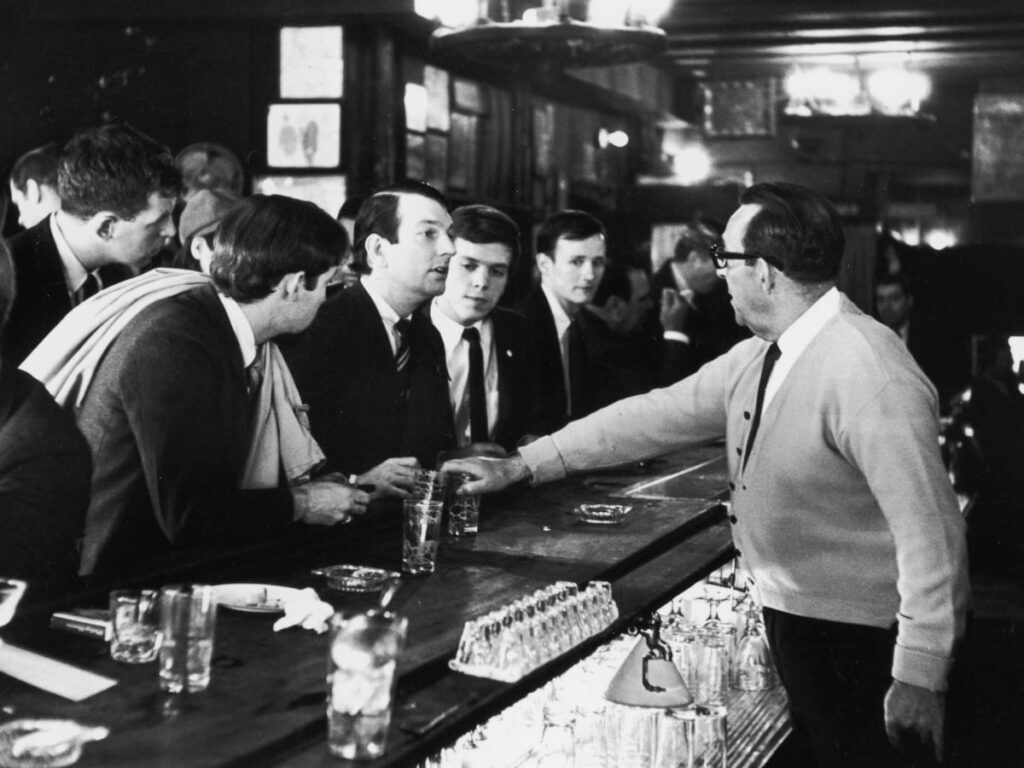
Upon learning the men were queer, the bartender refused to serve them — even covering a nearby glass with his palm, which journalist Frank Darragh captured in an iconic photo for the Village Voice
In the 1960s, the New York State Liquor Authority (NYSLA) prohibited bars from serving alcohol to queer folks on the pretense that they were inherently engaging in disorderly behavior, according to the NYC LGBT Historic Sites Project. If a police raid found that a bar was serving LGBTQIA+ folks, the establishment could lose its liquor license. This didn’t criminalize gay bars in certain terms, but it did inherently criminalize any public gatherings of queer folks.
So on April 21, members of the Mattachine Society, one of the earliest gay rights groups with a focus on men 21+, organized a “Sip-In.” The event entailed activists Dick Leitsch, Craig Rodwell, and John Timmons visiting several bars, announcing that they were gay, and asking to be served. The men also brought journalists from outlets like the New York Times and the Village Voice. The hope was to have a documented record of the sip-in and spread the word about the discrimination LGBTQIA+ people faced. This event was considered radical for the otherwise-conservative Mattachine Society.
On the day of the event, the men visited four bars known to serve queer folks. Ultimately, two bars served them and one closed for the day after hearing about the sip-in. The last stop was Julius’, a bar where gay men were often served. As such, it had just been raided.
At the bar, the group was joined by Randy Wicker, another prominent New York City activist — and a critic of the Mattachine Society’s low-profile approach to activism. At Julius’, the men ordered drinks and told the bartender they were gay. Upon learning the men were queer, the bartender refused to serve them — even covering a nearby glass with his palm, which journalist Frank Darragh captured in an iconic photo for the Village Voice (depicted above). The organizers were able to use the sip-in as a basis for a lawsuit that prevented LGBTQIA+ people from gathering in public, the National Parks Service.
“When we took this action, we were legally challenging the state laws that said it was illegal to serve homosexuals alcohol or shall allow them to gather on your premises – that’s right of assembly,” Wicker told the NYC LGBT Historic Sites Project.
Julius’, which is still open today, was added to the National Parks Services National Register of Historic Places in 2016 after nomination from the NYC LGBT Historic Sites Project.
More on Julius’:
Book: “Mattachine Society: The Trojan Horse that Introduced Homosexuality into America” by Michael Hone
Podcast: Weekend Edition: Remembering a 1966 ‘Sip-In’ for Gay Rights
Compton Cafeteria riot – August 1966
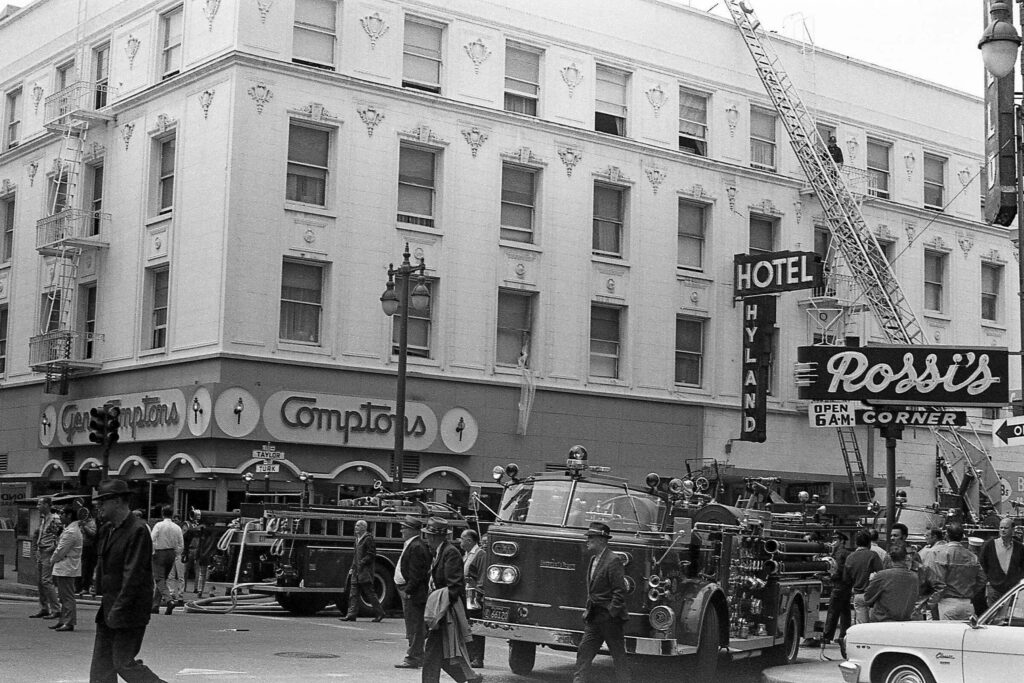
Firefighters respond to a fire at the Hyland Hotel in 1970. To the left is Compton’s Cafeteria, the site of a historic queer riot in 1966. There are few known images that show the exterior of the diner, signage included.
The story of the Compton Cafeteria Riot may have been lost to history if not for noted trans historian Susan Stryker, who stumbled upon a one-sentence reference to the event in the Gay and Lesbian Historical Society Aarchives back in 1991.
In 1966, San Francisco’s Tenderloin district was known as a “mecca” for gay and trans folks — and Gene Compton’s Cafeteria was at the heart of it all, as it was one of the few establishments where LGBTQIA+ folks could safely socialize.
That all changed in August 1966, when a police officer raided the 24-hour restaurant and attempted to arrest a trans woman, whose identity isn’t known. The woman refused to be handcuffed, apparently throwing a cup of coffee in the officer’s face, per Advocate.
It didn’t take long after that for the rest of the patrons to join in the protest. The event resulted in the arrest of trans women, destruction of diner windows and property, burning of a newsstand, and damage to a cop car. After that, Gene Compton’s cafeteria stopped serving LGBTQIA+ folks.
Little else is known about the event — including the date, who was arrested, names of the police officers, or how many people were present at the time. There are no surviving news reports or police filings related to the event, as city officials told The Guardian that “records have been disappeared.”
More on Compton’s Cafeteria Riot:
Documentary: “Screaming Queens: The Riot at Compton’s Cafeteria”
Podcast: Stuff You Missed in History Class: Compton’s Cafeteria Riot
Black Cat Riot – January 1, 1967
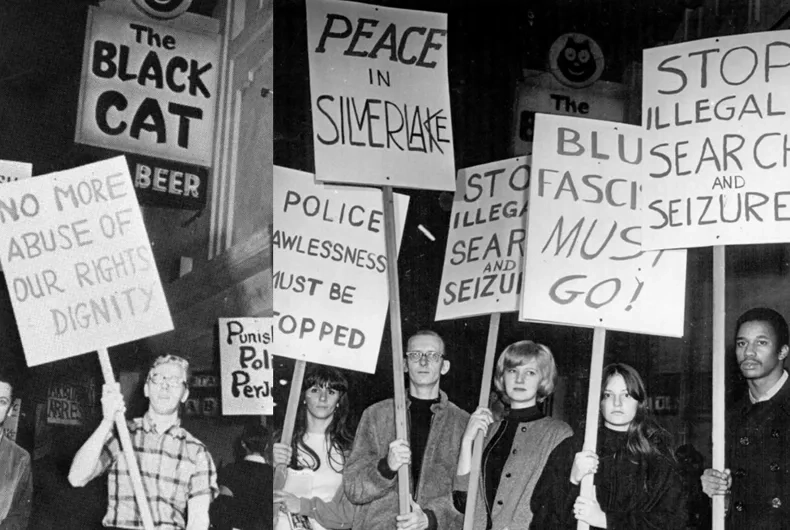
The Black Cat Tavern, also called the Black Cat, was a queer watering hole in Los Angeles’ Silver Lake neighborhood, partially because it was one of the few establishments that served queer folks. This service also made the bar subject to frequent, brutal police raids as homosexuality was criminalized at this time, per the ONE Archives at the USC Library.
The most notable raid happened just after midnight on January 1, 1967. Plainclothes police officers entered the bar before midnight. When the clock struck 12 and men began to kiss each other. The police physically separated couples and brought in back up in the form of uniformed officers who had been waiting and at the ready.
From there, the raid turned violent, with patrons being beaten. Slowly, the chaos moved into a neighboring gay bar, where police beat the patrons and employees indiscriminately. That night, 14 people were arrested for lewd conduct, and two men who had kissed at midnight were required to register as sex offenders.
Alexei Romanoff, who was at Balck Cat at the time, worked with a PRIDE (Personal Rights in Defense and Education) to put organize a demonstration. On February 11, 1967, over 200 people gathered in front of Back Cat in protest of police brutality and institutionalized homophobia. Romanoff described the event as “angry.” It included speeches, leaflets, posters, and a picket line.
Notedly, the signs didn’t reference homosexuality so as not to compete with a similar one on the same day. Although there was a large police presence on the day of the Black Cat protest, Romanoff said it remained “orderly,” as attendees didn’t want police to feel justified in their aggressive tactics.
More on Black Cat:
Short Film: “LGBTQ Historic Places in L.A.”
Podcast: Morning Edition: Stonewall Riots Grab The Spotlight From Black Cat Protests
CONCLUSION
LGBTQIA+ people have always existed, but their collective past has been marked by discrimination, humiliation, and violence. Not long ago, it was hard to imagine the pain associated with codified discrimination. The past decades have seen advances, including the right to marriage equality and the end of don’t ask don’t tell. To be certain, those victories were hard-fought and won by decades of organizers — in particular trans women of color, who have always pushed the movement for queer rights forward.
But in recent months, LGBTQIA+ folks have been reminded that safety is not a right for marginalized people, but an allowance that can be taken away at the whims of oppressors.
Currently, black trans women are facing an epidemic of violence — and posthumous transphobia. In 2022, Florida passed a “don’t say gay” bill, which prohibits educators from referencing anything pertaining to LGBTQIA+ identity in the classroom until students are in the 4th grade. In the last year, 36 states have introduced anti-trans legislation. This amounts to an overall threat to the safety, mental health, and quality of life of queer youth — and especially trans youth. Treating any deviation from cis-heteronormativity as criminal or sexual in nature is a giant backward in the wrong direction for queer liberation — and joy.
Then, in late June 2022, the US Supreme Court made the harrowing decision to overturn Roe v. Wade, effectively prohibiting access to safe abortions across the country. The majority decision, which was written by Justice Samuel Alito, said that Roe was never constitutional, as it restricted states’ rights by granting people bodily autonomy and reproductive freedom. After the decision’s release, Justice Clarence Thomas concurred that the same standard “should be considered” when it comes to the cases that respectively protect the rights to contraception, same-sex relationships, and same-sex marriage.
In these times, it’s pertinent that the queer community look to the past not out of fear, but for guidance and the path forward through organizing and action.
WHAT CAN I DO?
This pride, vote with your dollars — and at the ballot box. To support LGBTQIA+ people all year long you can…
- Vote for candidates who will protect LGBTQIA+ rights in every single local and federal election.
- Listen to established organizers — and follow their lead instead of reinventing the wheel.
- Study the past because history is doomed to repeat itself otherwise.
- Donate to groups that support LGBTQIA+ rights. This list compiled by Cosmo is a great place to start.
- Shop businesses owned by LGBTQIA+ people….especially B Corps owned by queer folks!
- Write to your representatives and let them know what matters to you. Find your representative here.
By Susie Heller
June 29, 2022
